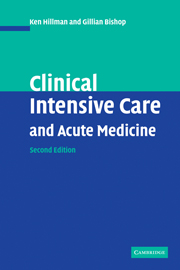Book contents
- Frontmatter
- Contents
- List of troubleshooting tips
- Preface to the first edition
- Preface to the second edition
- Acknowledgements
- 1 A systematic approach to caring for the seriously ill
- 2 Organisation of an intensive care unit
- 3 Routine care of the seriously ill
- 4 Fluid therapy and electrolytes
- 5 Nutrition and metabolism
- 6 Acid–base balance
- 7 Sedation, analgesia and muscle relaxants
- 8 Shock and anaphylaxis
- 9 Multiorgan failure
- 10 Cardiopulmonary resuscitation
- 11 Body temperature disorders
- 12 Transport of the seriously ill
- 13 Infection
- 14 Trauma
- 15 Poisoning
- 16 Acute respiratory failure
- 17 Interpretation of the portable chest film
- 18 Specific respiratory problems
- 19 Ventilatory techniques
- 20 Cardiorespiratory monitoring
- 21 Acute cardiovascular failure
- 22 Specific cardiovascular problems
- 23 Acute intracranial disasters
- 24 Specific intracranial problems
- 25 Critical care neurology
- 26 Acute renal failure
- 27 Critical care gastroenterology
- 28 Critical care haematology
- 29 Critical care endocrinology
- 30 Obstetric emergencies
- 31 Economics, outcome and ethics in intensive care
- Appendices
- Index
- References
25 - Critical care neurology
Published online by Cambridge University Press: 07 September 2009
- Frontmatter
- Contents
- List of troubleshooting tips
- Preface to the first edition
- Preface to the second edition
- Acknowledgements
- 1 A systematic approach to caring for the seriously ill
- 2 Organisation of an intensive care unit
- 3 Routine care of the seriously ill
- 4 Fluid therapy and electrolytes
- 5 Nutrition and metabolism
- 6 Acid–base balance
- 7 Sedation, analgesia and muscle relaxants
- 8 Shock and anaphylaxis
- 9 Multiorgan failure
- 10 Cardiopulmonary resuscitation
- 11 Body temperature disorders
- 12 Transport of the seriously ill
- 13 Infection
- 14 Trauma
- 15 Poisoning
- 16 Acute respiratory failure
- 17 Interpretation of the portable chest film
- 18 Specific respiratory problems
- 19 Ventilatory techniques
- 20 Cardiorespiratory monitoring
- 21 Acute cardiovascular failure
- 22 Specific cardiovascular problems
- 23 Acute intracranial disasters
- 24 Specific intracranial problems
- 25 Critical care neurology
- 26 Acute renal failure
- 27 Critical care gastroenterology
- 28 Critical care haematology
- 29 Critical care endocrinology
- 30 Obstetric emergencies
- 31 Economics, outcome and ethics in intensive care
- Appendices
- Index
- References
Summary
Myasthenia gravis
Myasthenia gravis is a neuromuscular disorder characterised by weakness and fatigability of voluntary muscles. The weakness is exacerbated by effort and improved by rest and it affects, in order of decreasing frequency, the ocular, bulbar, neck, limb, girdle, distal limb and trunk muscles.
It is a classic autoimmune disease marked by the presence of heterogeneous acetylcholine receptor antibody (IgG) in approximately 90% of symptomatic patients. The antibodies react with the receptor, block its action and accelerate receptor degradation. As a result, fewer receptors can be activated causing muscle weakness.
Diagnosis
Clinical suspicion and the finding of skeletal-muscle fatigability with repetitive exercise will support the diagnosis. The diagnosis can be confirmed by complete reversibility of muscle fatigue after IV administration of the rapidly acting anticholinesterase drug edrophonium (5–10 mg IV over 1 minute, should produce an effect within 10 minutes).
Electrophysiological testing will demonstrate progressive decline in muscle action potentials with repetitive stimulation of a motor nerve.
Treatment
Definitive treatment aims to reduce antibody production and/or increase the effect of unaffected acetylcholine receptors.
Anticholinesterases
The longer-acting anticholinesterase, pyridostigmine, is titrated against patient response using a starting dosage of 60 mg orally four times daily. Excessive use of anticholinesterases can cause a cholinergic crisis, with progressive muscle weakness as well as muscarinic effects, such as abdominal colic, diarrhoea, small pupils, lachrymation and excessive salivation.
Thymectomy
Among all patients with myasthenia gravis, 75% have thymic abnormalities. Most have thymic hyperplasia, but up to 15% have thymomas.
- Type
- Chapter
- Information
- Clinical Intensive Care and Acute Medicine , pp. 509 - 522Publisher: Cambridge University PressPrint publication year: 2004



